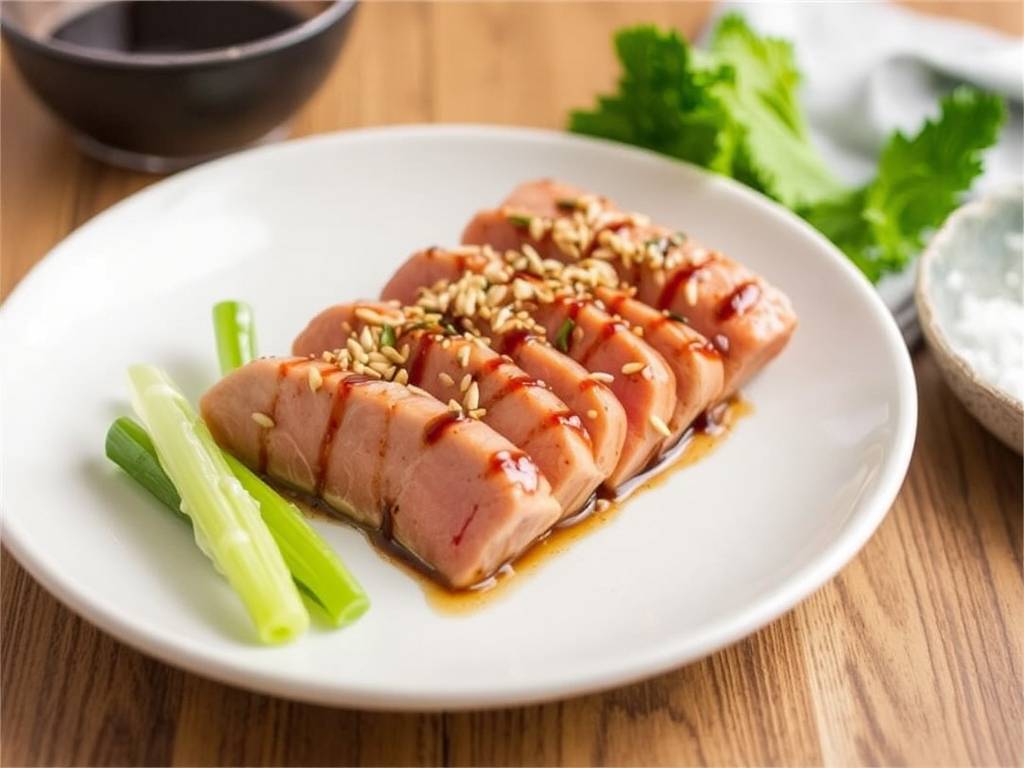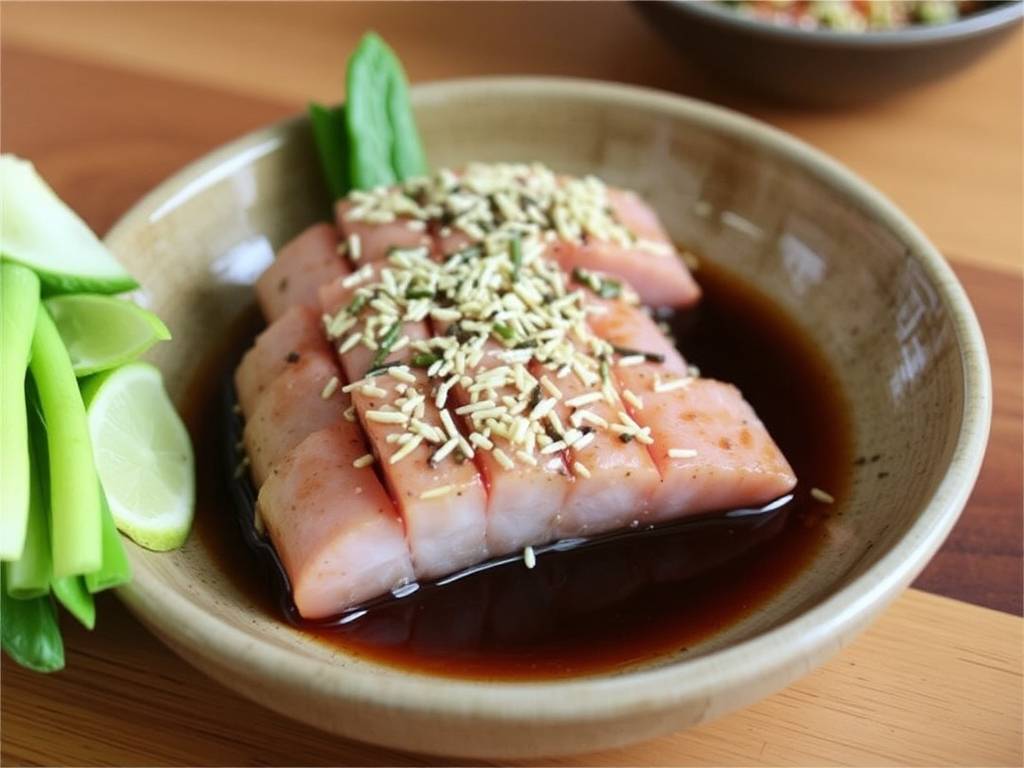Mastering the Art of Grilling Tuna with Sesame and Soy Sauce
The sizzle of a pristine tuna steak meeting a hot grill is a sound that promises something extraordinary. It is the prelude to a dish that balances primal fire with sophisticated flavor, where the rich, meaty texture of the tuna is elevated by the ancient, umami-rich alchemy of sesame and soy. Grilling tuna is not merely cooking; it is an exercise in precision and restraint, a dance with heat where seconds are the difference between a succulent, ruby-centered masterpiece and a dry, overcooked disappointment. When paired with the nutty depth of sesame and the salty-sweet complexity of soy sauce, this dance becomes a culinary sonnet.
The journey to a perfect grilled tuna begins not at the grill, but at the market. The quality of your main ingredient is paramount. For grilling, you want a cut that can stand up to high heat without falling apart. The ideal choices are Ahi (Yellowfin) or Bigeye tuna. These species have a firm texture and a rich flavor that is complemented, not overwhelmed, by robust marinades. Look for steaks that are at least one inch thick, preferably closer to one and a half. This thickness is crucial for achieving that coveted seared crust while maintaining a cool, rare center. The flesh should be a vibrant, deep red, glossy, and smell fresh and clean, with no overly "fishy" odor. Avoid steaks with any discoloration or drying around the edges.

Once you have your perfect steak, the next critical step is preparation. If your tuna is frozen, thaw it slowly and completely in the refrigerator—never at room temperature. Pat the steak dry thoroughly with paper towels. This is a non-negotiable step. Moisture is the enemy of searing; a wet steak will steam instead of sear, preventing the development of that beautiful, flavorful crust. Let the tuna come to room temperature for about 20-30 minutes before grilling. A cold steak hitting a hot grill will cook unevenly, leaving you with an overcooked exterior before the interior has warmed.
The marinade for sesame-soy tuna is a study in balance. At its core, it is a simple combination, but each component plays a vital role.
- Soy Sauce: This is the base, providing saltiness and a profound umami depth. Use a good-quality soy sauce. Low-sodium versions are acceptable if you are watching salt intake, but they can be slightly less complex. For a deeper flavor, you might consider a combination of regular and dark soy sauce.
- Sesame Oil: This is the soul of the dish, offering an intense, aromatic nuttiness. Use toasted sesame oil, not the light, cold-pressed variety. Its flavor is potent, so a little goes a long way. It’s often best to add a portion to the marinade and then drizzle a bit more over the cooked steak just before serving to maximize its fragrance.
- Acid: A touch of acidity is essential to cut through the richness of the fish. Rice vinegar is a classic choice for its mild, slightly sweet profile. Freshly squeezed lime or lemon juice also works wonderfully, adding a bright, citrusy note.
- Sweetener: A hint of sweetness balances the saltiness of the soy. Mirin (Japanese sweet rice wine), honey, brown sugar, or even a touch of maple syrup are excellent options. The sweetener also encourages caramelization on the grill.
- Aromatics: Freshly minced garlic and grated ginger are indispensable. They infuse the tuna with a pungent, spicy warmth that complements the other flavors perfectly.
- Optional Enhancers: A splash of sake or dry sherry adds complexity. A teaspoon of Sriracha or a pinch of red pepper flakes can introduce a subtle heat. Toasted white and black sesame seeds are not just for garnish; they add a delightful crunch and reinforce the sesame theme.
A simple, effective marinade ratio could be: 1/4 cup soy sauce, 1 tablespoon toasted sesame oil, 1 tablespoon rice vinegar, 1 tablespoon honey or mirin, 2 cloves minced garlic, and 1 tablespoon grated ginger. Whisk these ingredients together in a shallow dish.
Place the dried tuna steak in the marinade, turning to coat it evenly. Here, timing is critical. Unlike tougher meats, tuna is delicate. Marinating for too long—more than 30 minutes—can actually begin to "cook" the fish from the acidity (a process called ceviche) and make the exterior mushy. For the best texture, a brief marinade of 15 to 30 minutes is ideal. This is long enough to impart flavor but short enough to preserve the tuna's integrity.
While the tuna is marinating, prepare your grill. This is where the magic happens, and the choice of heat source is important. Whether you use a gas grill or a charcoal grill, the goal is the same: intense, direct, high heat.
For a gas grill, preheat it to high (around 450-500°F or 230-260°C). For a charcoal grill, let the coals burn until they are covered with a layer of white-gray ash and are screaming hot. You should be able to hold your hand about four inches above the grill grate for no more than two seconds. A properly preheated grill is essential for that instant sear.
Just before grilling, brush the grill grates generously with a high-heat oil like canola, grapeseed, or avocado oil. This prevents sticking. Remove the tuna from the marinade and let the excess drip off. You can pat it very lightly with a paper towel if it seems too wet, but a thin layer of marinade will help with caramelization.
Now, for the main event. Place the tuna steak on the hottest part of the grill. You should hear an immediate, aggressive sizzle. Do not move it. Let it sear undisturbed. The cooking time depends entirely on the thickness of your steak and your desired level of doneness. For a one-inch steak:

- Rare (highly recommended): Grill for approximately 1.5 to 2 minutes per side. The center will be deep red and cool.
- Medium-Rare: Grill for 2.5 to 3 minutes per side. The center will be pink and warm.
- Medium and beyond: We do not recommend grilling tuna beyond medium. The flesh becomes dry, flaky, and loses its unique character.
A good rule of thumb is to cook for about 90 seconds per side for every inch of thickness for rare. Use a timer! It is incredibly easy to overcook tuna. To achieve those attractive cross-hatch grill marks, rotate the steak 45 degrees halfway through the cooking time on the first side.
Resist the urge to constantly press down on the tuna or flip it multiple times. You want to develop a crust. The best tool for checking doneness is an instant-read thermometer. For rare, aim for an internal temperature of 115-125°F (46-52°C). For medium-rare, 125-135°F (52-57°C). Remember that the tuna will continue to cook from residual heat after it's removed from the grill (carryover cooking), so it's wise to pull it off just before it reaches your target temperature.
Once grilled to perfection, the final, crucial step is to let the tuna rest. Transfer it to a clean cutting board and let it sit for 5-10 minutes. This allows the juices, which have been driven to the center by the heat, to redistribute throughout the steak. Slicing it immediately will cause those precious juices to run out, leaving the tuna dry.
After resting, use a sharp knife to slice the steak against the grain into 1/2-inch thick slices. This showcases the beautiful interior and makes for an elegant presentation. Drizzle with a little extra toasted sesame oil and a sprinkle of toasted sesame seeds. A squeeze of fresh lime juice and a scattering of thinly sliced scallions or a few cilantro leaves add a final burst of freshness.
Grilled sesame-soy tuna is incredibly versatile. It can be the star of a composed salad with mixed greens, avocado, and a ginger-soy vinaigrette. It can be served atop a bowl of sushi rice or soba noodles for a hearty meal. It makes fantastic tacos when tucked into warm tortillas with a crunchy slaw. Or, it can simply be enjoyed on its own, perhaps with a side of grilled asparagus or edamame, allowing the pure, unadulterated flavors to shine.
Mastering this dish is about respecting the ingredients and understanding the process. It teaches the importance of quality, the power of a balanced marinade, the necessity of fierce heat, and the virtue of patience. Each step, from selection to slicing, is a building block in creating a dish that is deceptively simple yet profoundly delicious. It is a testament to the fact that the best recipes often rely not on complexity, but on technique and the ability to highlight a magnificent ingredient at its peak. So, light your grill, gather your ingredients, and prepare to embark on a culinary journey that culminates in the perfect bite—a symphony of smoke, sesame, soy, and sublime tuna.






发表评论